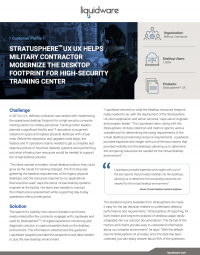Defense Contractor Uses Stratusphere UX to Scale Training Center
A U.S. defense contractor was tasked with modernizing the operational desktop footprint for a high-security computer training center for military personnel. Training center leaders planned a significant facility and IT renovation to augment classroom space and replace physical desktops with virtual ones. Before the expansion and upgrade could begin, the leaders and IT operations teams needed to get a complete and objective picture of how their desktop systems were performing and what infrastructure resources would be needed to support the virtual workspace solution. They wanted an environment that could easily scale as the need for training changed.
The search for visibility into current utilization and future needs ended after the contractor engaged with Liquidware and used its Stratusphere UX digital experience monitoring and diagnostic solution to capture baseline data on the desktop environment. The information collected and the guidance Liquidware provided the perspective and data needed to size the new desktop environment. The standard reports available from Stratusphere UX made it easy for the top decision-makers to understand desktop performance and requirements.
The training center deployed 600 virtual desktops for over 1,000 endpoints, all running Stratusphere UX’s seamless client, with accurate reports on both active and trending system requirements. The solution has been key in helping to size the virtual environment and maintain monitoring of the provisioned desktops through detailed logon monitoring, capacity planning and resource utilization reports. The training center retained Stratusphere UX after the rollout and relies on it every day as a key component for monitoring and managing the environment. The organization has maintained its high desktop performance levels and customer satisfaction levels at the training center, all while continuing to scale the virtual desktop environment. Now, the facility’s scope has expanded to support more than 2,500 total endpoints, with over 2,000 provisioned virtual desktops.

